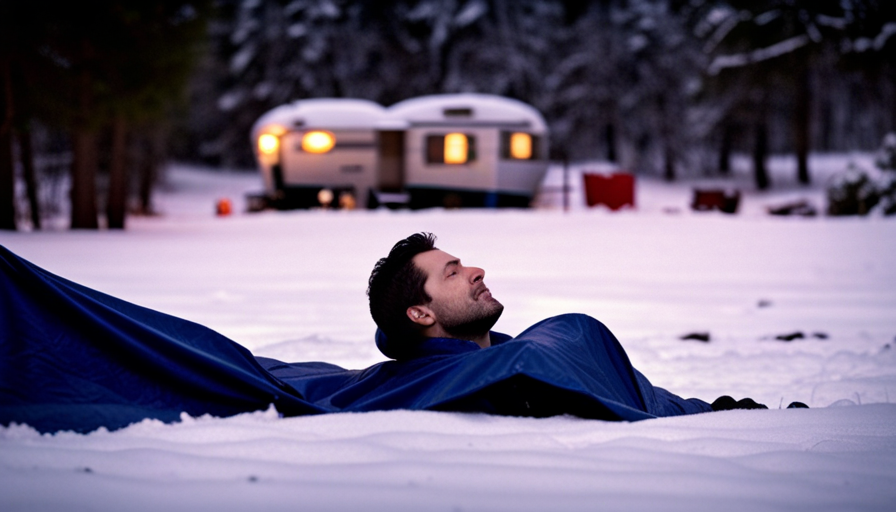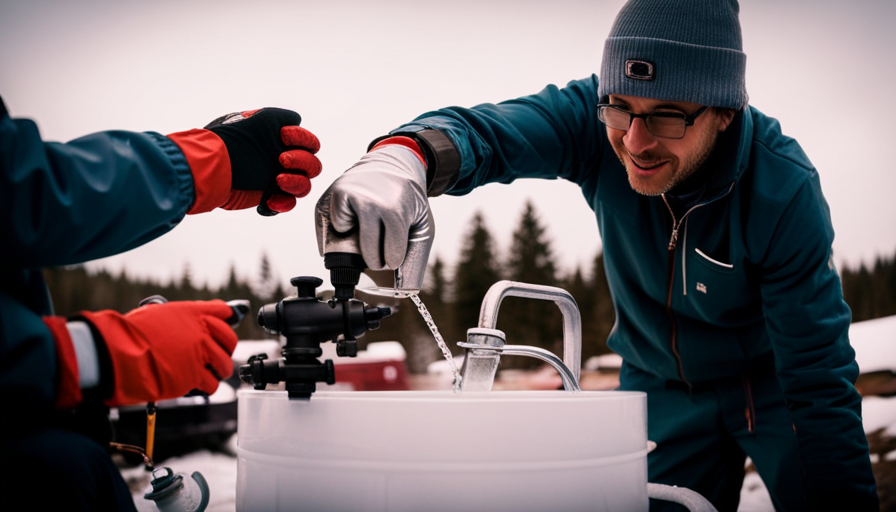Winter carries a special charm, characterized by snug evenings beside the fireplace and scenic views of landscapes blanketed in snow. Yet, for those of us who own campers, we understand that this season also presents a number of obstacles. The freezing cold, substantial snow accumulation, and slippery ice can cause significant damage to our cherished campers without the right protection.
That’s where the art of tarping comes in. It may seem counterintuitive, wrapping a camper in a giant sheet of plastic, but trust us, it’s a necessary step to ensure its longevity. In this article, we will guide you through the process of tarping your camper for winter, providing you with all the necessary steps, materials, and tips to keep your home away from home safe and sound during the harshest season of the year.
So grab your gloves and let’s get started!
Key Takeaways
- Choose a durable tarp material such as canvas or polyethylene for camper protection in winter.
- Secure the tarp tightly with bungee cords or ropes to prevent wind damage and snow buildup.
- Create ventilation openings using roof vents, window vents/vent covers, or battery-powered fans/dehumidifiers to prevent moisture build-up and mold growth.
- Properly clean and store the tarp in a dry place to ensure longevity and future use.
Assess Your Camper’s Needs
Now it’s time for us to take a moment and really assess what our camper needs to brave the harsh winter ahead.
The first thing we need to consider is the insulation of our camper. Is it properly insulated to withstand freezing temperatures? If not, we may need to take some additional steps to ensure that our camper stays warm and protected.
We should also determine the best winter storage location for our camper. Do we have access to a covered storage facility or do we need to find a safe spot on our property? It’s important to choose a location that is sheltered from the elements and provides ample protection from snow, ice, and wind.
Once we have assessed our camper’s insulation and determined the winter storage location, we can move on to gathering the necessary materials. This will include a tarp, bungee cords, and other items to secure the tarp in place.
Gather the Necessary Materials
When preparing to tarp a camper for winter, we need to gather the necessary materials. First and foremost, it’s important to choose a durable tarp material that can withstand harsh weather conditions. Look for a tarp made of heavy-duty polyethylene or vinyl, as these materials are known for their durability.
Additionally, make sure to get bungee cords or ropes for securing the tarp tightly to the camper, ensuring that it stays in place even during strong winds or storms.
Choose a durable tarp material
To keep your camper protected during the harsh winter months, opt for a tough-as-nails tarp material that will shield it like a suit of armor.
When choosing a tarp material, there are two main options to consider: canvas and polyethylene. Canvas tarps are known for their durability and resistance to tearing, making them an excellent choice for long-term use. On the other hand, polyethylene tarps are lightweight and waterproof, providing effective protection against snow, rain, and UV rays.
Factors to consider when choosing a tarp material include the climate in your area, the size of your camper, and your budget. Regardless of the material you choose, make sure it is thick enough to withstand strong winds and heavy snowfall.
Once you’ve selected the right tarp material, the next step is to secure it using bungee cords or ropes, ensuring a tight and secure fit over your camper. Transitioning into the subsequent section, securing the tarp properly is essential to prevent any potential damage or leaks.
Get bungee cords or ropes for securing the tarp
Make sure you have the essential tools, such as bungee cords or ropes, to securely fasten your protective shield and safeguard your beloved camper from any potential damages.
Here are three tarp securing techniques to consider:
-
Bungee cords: These elastic cords are easy to use and provide a secure hold. Simply attach them to the tarp and loop them around the camper’s frame or tie-down points.
-
Ropes: Opt for sturdy ropes that can withstand winter conditions. Use them to tie down the tarp tightly, ensuring it doesn’t shift or come loose during strong winds.
-
Alternative tarp materials: If you’re looking for an alternative to traditional tarps, consider heavy-duty canvas or vinyl options. These materials offer excellent durability and protection against harsh weather elements.
Now that you have your tarp securing techniques in place, it’s time to move on to the next step and clean and prepare your camper for winter storage.
Clean and Prepare Your Camper
Before you start prepping your camper for winter, be sure to give it a thorough cleaning to ensure it’s ready for storage. Proper camper maintenance is essential to prevent any damage during the winterization process.
Begin by removing all personal belongings and cleaning out any food crumbs or debris that may attract pests. Use a mild detergent and water to wash the exterior of the camper, paying attention to areas prone to dirt and grime buildup, such as the windows, doors, and awnings.
Inspect the roof for any signs of damage or leaks, and repair them if necessary. It’s also a good idea to clean and treat the camper’s interior surfaces, including the floors, countertops, and upholstery, to prevent any mold or mildew growth.
Additionally, empty and clean out all water tanks and lines to prevent freezing and potential damage. Once your camper is clean and dry, you can proceed to cover the roof of your camper, ensuring its protection from winter weather and elements.
Cover the Roof of Your Camper
Once you’ve thoroughly cleaned and prepared your camper for winter, it’s time to ensure the roof is protected with a durable covering.
There are several waterproofing options available to safeguard your camper from the harsh winter elements. One popular choice is using a camper cover specifically designed for this purpose. These covers are made from high-quality materials that provide excellent protection against rain, snow, and UV rays. They’re also easy to install and remove, saving you time and effort.
One of the benefits of using a camper cover is that it prevents water from seeping into the roof, which can lead to costly water damage and mold growth. The cover acts as a barrier, keeping your camper dry and in good condition throughout the winter season. Additionally, it protects the roof from debris such as falling leaves and branches, reducing the risk of scratches and dents.
To transition into the next section about wrapping the sides of your camper, it’s important to note that the roof cover is just one part of the overall process of winterizing your camper.
Now that the roof is protected, we’ll move on to securing the sides of your camper.
Wrap the Sides of Your Camper
When it comes to protecting our camper during the winter months, extending the tarp over the sides is crucial. This extra coverage not only shields the exterior from harsh weather conditions but also helps to keep the interior dry and secure.
To ensure the tarp stays in place, it’s important to secure it tightly using bungee cords or ropes, preventing any potential wind damage.
Extend the tarp over the sides
Now that you’ve secured the tarp to the roof, it’s time to extend it over the sides of the camper for added protection during the winter months. Here are some tarp installation tips to help you keep your camper safe and secure:
-
Start by draping the tarp evenly over one side of the camper, making sure it reaches all the way down to the ground.
-
Use bungee cords or rope to attach the tarp to the bottom of the camper, ensuring a tight and secure fit.
-
Repeat this process for the other side of the camper, ensuring that the tarp is taut and free from any wrinkles or sagging.
-
Make sure to overlap the tarp at the corners of the camper to create a seal against the elements.
By following these tips, you can ensure that your camper is fully protected from the harsh winter weather.
Now, let’s move on to the next step: securing the tarp tightly to prevent wind damage.
Secure the tarp tightly to prevent wind damage
To prevent wind damage, it’s crucial to tightly secure the tarp by using strong bungee cords or rope. This ensures that it stays in place even during strong gusts of wind.
For example, imagine a powerful winter storm with strong winds attempting to tear the tarp off. But the tightly secured cords hold it firmly in place, protecting the camper beneath.
In addition to wind, securing the tarp effectively also prevents snow buildup, which can cause significant damage. By tightly securing the tarp, you create a barrier that prevents snow from accumulating on the camper’s roof and sides, reducing the risk of collapse or structural damage.
Now that you understand the importance of securing the tarp tightly, let’s move on to the next step: securing the tarp at the bottom.
Secure the Tarp at the Bottom
Start by tightly folding the tarp over the bottom of the camper and securing it with bungee cords, ensuring a snug fit that’ll protect your camper from harsh winter weather.
When securing the tarp at the bottom, there are several techniques you can use to ensure it stays in place. One effective method is to fold the excess tarp underneath the camper and use bungee cords to secure it to the frame. This prevents wind from getting underneath the tarp and causing it to flap or tear.
Another option is to use heavy-duty clips or clamps to hold the tarp tightly to the bottom of the camper. These clips can be attached to the tarp and then secured to the camper’s frame or any available anchor points.
If you’re looking for alternative tarp fastening methods, consider using ropes or tie-down straps instead of bungee cords or clips. You can loop the ropes through the grommets on the tarp and tie them securely to the camper’s frame, creating a strong and reliable hold. Additionally, tie-down straps can be used to cinch the tarp tightly around the bottom of the camper, providing extra security.
Creating ventilation openings is crucial to prevent moisture build-up and mold growth inside your camper during the winter. To transition into the next section, let’s discuss how to create these necessary openings while still keeping your camper protected from the elements.
Create Ventilation Openings
Make sure you allow fresh air to circulate inside your cozy winter shelter by creating ventilation openings. It’s essential to maintain proper airflow inside a camper during winter to prevent condensation and mold growth.
There are different ways to create ventilation in a camper during winter. One option is to install roof vents that can be opened and closed as needed. These vents allow hot and humid air to escape while letting fresh air in.
Another method is to use window vents or vent covers. These can be easily installed over the existing windows and provide a controlled airflow. Additionally, you can use battery-powered fans or dehumidifiers to improve air circulation and reduce moisture.
Remember to regularly check and adjust the ventilation openings to ensure they’re functioning properly. Proper airflow is crucial for maintaining a comfortable and healthy environment inside your camper during the winter months.
Transitioning into the next section, it’s important to regularly check and adjust these ventilation openings to ensure they’re effectively providing fresh air while keeping the cold air out.
Check and Adjust Regularly
Regularly checking and adjusting the ventilation openings ensures that fresh air circulates effectively and avoids any potential issues with condensation or mold growth. Proper ventilation is crucial for maintaining the overall health and condition of your camper during the winter months.
Regular maintenance of the ventilation openings will ensure that they remain clear and unobstructed, allowing for adequate airflow.
During winter weather protection, it’s important to check these openings on a regular basis. Snow, ice, or debris may accumulate and block the vents, hindering the circulation of fresh air. By inspecting and adjusting the openings, you can remove any obstructions and ensure that the ventilation system operates optimally.
In addition to checking for blockages, it’s also essential to adjust the ventilation openings based on the weather conditions. During extremely cold temperatures, you may need to partially close the vents to prevent excessive cold air from entering the camper. Conversely, on milder days, you can open the vents wider to allow for increased airflow.
Regularly maintaining and adjusting the ventilation openings will help keep your camper in good condition throughout the winter. By ensuring proper airflow, you can prevent condensation and mold issues that can cause damage to your camper.
As we move onto the next section about removing the tarp in the spring, it’s important to note that proper ventilation during winter is equally important as the subsequent steps for spring maintenance.
Remove the Tarp in the Spring
When spring arrives, you’ll want to uncover your outdoor shelter to let the fresh air in and prepare for the upcoming camping season. Removing the tarp in the spring is an important step to prevent mold and mildew from developing on your camper.
Start by carefully removing any straps or bungee cords that are securing the tarp in place. Slowly peel back the tarp, being careful not to shake it too vigorously to avoid releasing any accumulated debris onto your camper.
Once the tarp is completely removed, inspect it for any signs of damage or wear. If there are any holes or tears, patch them up before storing the tarp properly. It’s important to store the tarp in a dry and clean area to prevent moisture and pests from damaging it.
Consider folding the tarp neatly and placing it in a plastic storage bin or a large garbage bag. This will keep it protected until it’s time to cover your camper again in the upcoming winter season.
Store the Tarp Properly
Now that we’ve learned how to remove the tarp from our camper in the spring, it’s important to know how to store the tarp properly to ensure its longevity. Proper tarp storage and maintenance are crucial in keeping the tarp in good condition for the next winter season.
Here are some tips to help you with tarp storage:
-
Clean the tarp: Before storing the tarp, make sure to clean it thoroughly. Remove any dirt, debris, or stains using a mild soap and water solution. Allow it to dry completely before proceeding to the next step.
-
Fold it neatly: Start by folding the tarp in half lengthwise, making sure to align the edges. Then, fold it in half again, this time widthwise. Continue folding until you have a compact and manageable size.
-
Store in a dry place: Find a cool and dry storage area for your tarp. Moisture can lead to mold and mildew growth, which can damage the tarp. Avoid storing it in direct sunlight or in a place with extreme temperatures.
-
Check periodically: Even when in storage, it’s important to check on your tarp periodically. Inspect for any signs of damage or wear and tear. If any issues are found, address them promptly to prevent further damage.
By following these steps, you can ensure the proper storage and maintenance of your tarp, extending its lifespan and keeping it in excellent condition for future use.
Frequently Asked Questions
How often should I check and adjust the tarp during winter?
We should check and adjust the tarp during winter on a regular basis to ensure the camper is well-protected. While it’s not necessary to obsessively monitor the tarp, it’s important to strike a balance between neglect and excessive fussiness.
I would recommend checking the tarp every couple of weeks or after any major weather event. This will help identify any potential issues such as sagging or tearing, allowing for prompt adjustments to maintain the camper’s protection.
What are the best materials to use for securing the tarp at the bottom?
When it comes to securing a tarp for winter tarping, it’s essential to choose the right materials. We recommend using strong and durable materials such as bungee cords or ratchet straps. These will provide a secure hold and withstand harsh winter weather conditions.
Additionally, consider using anchors or stakes to further secure the tarp at the bottom. By using these materials, you can ensure that your camper is protected throughout the winter season.
Can I use a regular tarp or do I need a specific type for covering my camper?
Choosing the right tarp for your camper during winter is crucial to ensure proper protection. Regular tarps may not be sufficient as they may not be designed to withstand harsh winter conditions. It’s recommended to use a specific type of tarp that’s made from durable and waterproof materials. Additionally, proper tarp maintenance during winter is essential to prevent any damage or leaks. Regularly inspect the tarp for tears or holes and address any issues promptly to maintain its effectiveness.
Are there any specific ventilation openings I should create to prevent moisture buildup?
To prevent condensation and moisture buildup inside your camper during winter, it’s essential to create proper ventilation options. This can be achieved by strategically placing vents or openings in key areas. Consider installing roof vents or using vent covers to allow air circulation without letting in rain or snow.
Additionally, adding moisture-absorbing products like desiccant packs or dehumidifiers can help maintain optimal humidity levels inside the camper. These measures will ensure a dry and comfortable winter storage for your camper.
How should I store the tarp properly to ensure its longevity?
How should we store the tarp properly for its longevity?
To ensure the tarp’s durability, it’s important to follow proper tarp storage and maintenance tips. First, clean the tarp thoroughly and let it dry completely before folding.
Next, fold the tarp neatly, avoiding sharp creases that can weaken the material.
Store the tarp in a cool, dry place away from direct sunlight and extreme temperatures.
Regularly inspect the tarp for any signs of damage and address them promptly to prolong its lifespan.
Conclusion
In conclusion, tarping a camper for winter is a crucial step in protecting it from the harsh elements. By following the steps outlined in this article, we can ensure that our camper remains in great condition throughout the cold season.
Remember to assess your camper’s needs, gather the necessary materials, and clean and prepare it before covering it with a tarp. By creating ventilation openings and regularly checking and adjusting the tarp, we can prevent any damage that may occur.
Finally, when spring arrives, remove the tarp and store it properly for future use. With these practical tips, your camper will be ready to hit the road again in no time!











